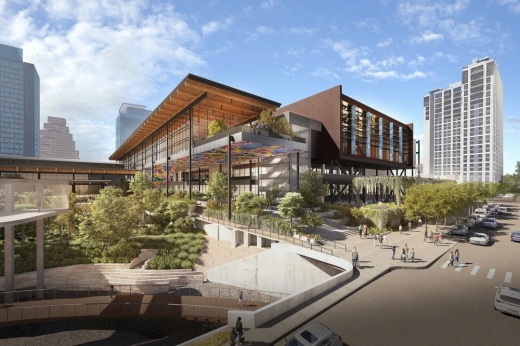City Council signed off on hundreds of millions of dollars of new spending related to the Austin Convention Center redevelopment this fall.
The financing items and overall project were strongly backed by downtown business leaders and hoteliers, who cited the convention center as an "economic engine" supporting local jobs and Austin's place in the tourism industry. Council's vote came over the opposition of some residents promoting a campaign to halt the expansion, who said the project is unnecessary and pulling resources from cultural programs.
What happened
The Austin Convention Center is going through a multi-year $1.65 billion redevelopment, called UnconventionalATX, that began this spring and will wrap up by late 2028. The more than 30-year-old building was demolished and is now being replaced by a larger convention facility with more exhibition and public space.
The project
Council approved several items related to the center's financing, construction and promotion on Oct. 23 including:
- A $450 million addition to the city's original $1.2 billion construction contract with partners JE Dunn and Turner for work on the new convention center, plus an Austin Energy power facility and street upgrades
- A $540,000 addition to the city's original $1.2 million contract with Eis Design for marketing the project
- A fee waiver for Capital Metro's relocation of some infrastructure at its Red Line Station next to the convention center property
- Issuing $650 million in hotel occupancy tax, or HOT bonds for the expansion project, the first round of the project's $1.2 billion in total planned debt funding
- Issuing $46.18 million in bonds to refund previous debt financing from 2008 and 2012 for the original convention center
The majority of the $450 million JE Dunn/Turner contract addition—$241.5 million—is for excavation work, civic infrastructure upgrades and mobility improvements including CapMetro's updates around the downtown site.
In addition, of $207 million is coming from Austin Energy for the utility's District Cooling Plant 4.1, including both the plant and new piping.
AE operates a district chilling system that connects the heating and cooling systems of dozens of properties downtown via an underground pipe network. The power utility's DCP 4 was formerly located on the old convention center's roof and has now been removed; DCP 4.1 will be a standalone facility located across the street from the new campus.

"The decision to align the DCP 4.1 project with the Convention Center redevelopment was made to ensure the facility receives the necessary climate control while minimizing potential risks associated with schedule misalignment that could occur between the two projects if managed separately," AE spokesperson Matt Mitchell said. "DCP 4.1 incorporates modern, efficient systems and updated infrastructure that will enhance performance and reduce operational constraints across the downtown system.

Austin Transportation and Public Works will add new protected bike lanes, on-street parking and pedestrian crossings on Red River between Cesar Chavez and Fourth streets. Funding comes from traffic impact fees from private developers and the city's 2020 mobility bond, according to TPW.
"The end result will be a safe and complete street that connects to developer-built bike lanes through the Cesar Chavez intersection to the south, to the Convention Center site, and to the Cross Town Bikeway on 4th Street," TPW spokesperson Brad Cesak said.
One more thing
Separate from the construction updates, funding for Eis' "strategic communications support and community outreach" around the project was increased by 45%. The firm is meant to provide public updates and fact sheets, launch a website, and hold community engagement about the project.
Austin's original $1.2 million contract with Eis was approved in early 2024 for up to six years, covering more than the full length of the redevelopment. San Francisco-based Eis, with several local subcontractors, was the highest scorer in a public solicitation for the marketing project.
The contract's timeline and vendor responsibilities didn't change between last year and this fall's amendment. In a statement before council's vote, Austin Financial Services said more funding was needed to ensure "work continues without interruption."
On Oct. 28, the city's convention center department noted the "comprehensive and proactive public engagement program" already launched by the Eis team. Work completed so far includes the UnconventionalATX website, email newsletter distribution, creation of working groups for community stakeholders and local businesses, engagement at public meetings for the project, and other local partnerships.
"These coordinated outreach efforts have been instrumental in maintaining consistent public engagement and ensuring that the community remains informed and involved as the project progresses," Katy Zamesnik, the convention center's acting deputy director, said in a statement.
While questioning some of the October funding items, council member Marc Duchen said he'd like to see improved public outreach around civic developments like the convention center expansion.
“I may be incredibly naive in saying this, but my hope is that going forward with more information and transparency around these sort of the large, major capital projects, they can reduce some of the heartburn for everybody involved," he said.
Put in perspective
Supporters and opponents of the convention center project turned out to City Hall to testify on the new spending, and the merits of the redevelopment overall.
Downtown tourism leaders say the ongoing project is key for their future operations as they're already feeling negative impacts from the facility's closure, and fewer large events in town.
Hilton Austin General Manager Joe Bolash said the closure brought "immediate" business changes, and that the hotel has cut dozens of employees without typical convention activity this year. Scott Blalock, general manager of the JW Marriott Austin, said most of his business comes from major events and he's seeing double-digit decreases in monthly room occupancy.
“Halting the progress on, or God forbid eliminating this project downtown would be nothing short of catastrophic for this destination, for the downtown community, for the hotel community, and for the tens of thousands of hotel workers that wake up every morning and put a name tag on just like I do," said Jeff Donahoe, general manager of the Hyatt Regency Austin.

The Austin United political action committee ran a petition drive this year for a proposal to pause construction, and reallocate city HOT revenue that's largely funding the project. The PAC submitted a petition with more than 20,000 signatures in support this month and the city is currently vetting those materials. If validated, the measure would be likely be decided in a May election.
"It typically takes a minimum 30 days to complete the verification process and analyze the results for before a certification can be issued. The Convention Center completed demolition last week, is in active excavation and construction, and the project is on schedule and on budget," the city said in a statement.
Resident and Austin United supporter Betsy Greenberg said the election is needed to give residents more input on Austin's HOT.
“We deserve to have a community discussion about how to spend the hotel occupancy tax revenue and about how to use that valuable downtown land," she said.

While Austin United is rallying to increase arts funding, it's unclear what that shift might look like. The group's petition directs City Council to prioritize using tourism tax dollars to "substantially increase promotion and support for cultural and outdoor tourism."
As PAC members submitted their petition this month, attorney and advisor Bill Bunch said the campaign is aimed at balancing Austin's HOT funding.
"With this petition, it will force the city council to call time-out and give us a vote on this enormous debt that they’re currently going to strap onto the shoulders of our young voters, in particular," he said. "At the same, they’re starving out what actually brings visitors here ... arts, live music, local restaurants and businesses, and our beautiful nature in the city parks."
Officials previously increased the share of HOT that could be used on the Austin Convention Center, but other spending of those taxes is limited under state law and wouldn't immediately go toward cultural initiatives if voters halt the project. Backers of the redevelopment noted there'd be more cultural funding available with more HOT revenue overall, gains that are projected with the expanded convention center.
“Austin collects more HOT for arts and heritage than any other city in the state of Texas, and we’re proud of that. But we are at our 15% max in those buckets," said Tom Noonan, Visit Austin president and CEO. "The only way to grow arts and heritage funding is to grow overall HOT collections. Not having a convention center is not going to help us."
Mayor Kirk Watson has also dismissed efforts to stall the project, saying a new facility is "long overdue" and will bring financial benefits for the city.
"[I]t’s perplexing that a group with the pretentious claim to 'save Austin’s soul' would be against investing in a key generator of Austin’s strong economy and our creative, funky, innovative, risk-taking, curious, welcoming, and wonderfully weird persona," he wrote of the Austin United campaign in a September newsletter.





